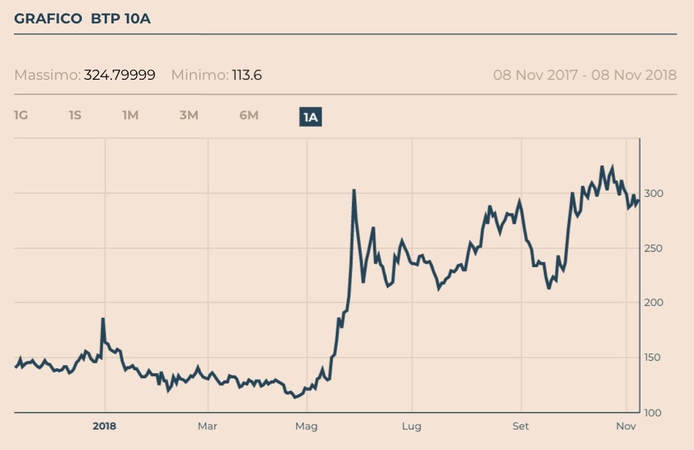A shudder political framework inaugurated an arduous period for Italian banks which are strained by the increasing spread of Italian 10-year debt over equivalent German bonds that is around, and more often than not over, 300 basis points. What is the risk of an increasing spread level? Well, the concern is that equity losses, even though not that heavy to require an increase in capital, could jeopardize the banks’ ability to provide credit to families and firms. The spread level erodes, in this sense, the foundation of the bank and this situation could definitely beget a domino effect. As a matter of fact the Italian finance minister Tria asserted that such a spread would not be sustainable for a medium/long period.
Italian banks are reeling because they owe in their balance-sheets 372bn of government’s debt and if the spread goes up, the government bonds possessed by the banks will lose value, generating an erosion of the capital of the bank itself. Fitch Ratings said "Italian banks are directly exposed through their holdings of Italian government debt, many of the country's banks hold large amounts of Italian sovereign debt relative to their capitalization." In particular, it has been estimated that every 100 points of spread erode the Common Equity Tier 1 (CET1) of 35 basis points. From January to June 2018 the major six banks had an erosion of 3,13bn euros of their CET1 due to the value loss of the BTPs (in particular Credit Suisse states that every 100 points of spread are associated with an erosion of 2,84bn of CET1 less).
It’s important to highlight that this capital drop is critical for banks since it could compromise their fundamental activity. To understand the significant percentage of capital that needs to be considered to make a judgment, we need to distinguish two thresholds:
Italian banks are reeling because they owe in their balance-sheets 372bn of government’s debt and if the spread goes up, the government bonds possessed by the banks will lose value, generating an erosion of the capital of the bank itself. Fitch Ratings said "Italian banks are directly exposed through their holdings of Italian government debt, many of the country's banks hold large amounts of Italian sovereign debt relative to their capitalization." In particular, it has been estimated that every 100 points of spread erode the Common Equity Tier 1 (CET1) of 35 basis points. From January to June 2018 the major six banks had an erosion of 3,13bn euros of their CET1 due to the value loss of the BTPs (in particular Credit Suisse states that every 100 points of spread are associated with an erosion of 2,84bn of CET1 less).
It’s important to highlight that this capital drop is critical for banks since it could compromise their fundamental activity. To understand the significant percentage of capital that needs to be considered to make a judgment, we need to distinguish two thresholds:
- The Phase-in, which is estimated taking into consideration the current legislation
- The Fully-loaded, which is calculated acknowledging the expected future legislation
Anyways, even though the fully-loaded is not considered by the ECB, its breaking through does has an impact: in fact, both the market and the ECB would notice it and this could put some banks and also the whole sector under pressure. So a high spread level is not fatal, but it is definitely damaging, not only for banks, but also for families and firms especially for a country like Italy where the largest share of firms is made by SMEs that finance themselves through bank loans. In this contest, with banks reeling, a budget fight with Europe will not help and the country’s banks may end up paying the price. In fact, an extended budget battle between the country's government and the European Union could cause bond prices to dip further, eroding the financial position of banks.
Now, taking into consideration the immediate effects of this situation, what concerns the most is the liquidity risk of the banks. As a matter of fact, the ECB and the Bank of Italy have intensified the monitoring asking the banks to report twice a week the liquidity situation. In this stressful scenario, Italian banks, that since the beginning of the year have burned 40bn of capitalization, have onerous bills: 86bn of bonds that will expire in the next three years, plus 250bn of loans to the ECB at a negative/zero rate and the emission of the MREL bonds for the bail in protocol. This definitely highlights an imminent possible liquidity risk.
Anyways as Mario Draghi said: “I don’t have a crystal ball to predict the spread, but BTPs are part of the Italian banks’ portfolio, and it is natural that there are effects on the capital, if they depreciate”. So, even though all the predictions, we still can only wait and see what will happen next.
Francesca Savi
Now, taking into consideration the immediate effects of this situation, what concerns the most is the liquidity risk of the banks. As a matter of fact, the ECB and the Bank of Italy have intensified the monitoring asking the banks to report twice a week the liquidity situation. In this stressful scenario, Italian banks, that since the beginning of the year have burned 40bn of capitalization, have onerous bills: 86bn of bonds that will expire in the next three years, plus 250bn of loans to the ECB at a negative/zero rate and the emission of the MREL bonds for the bail in protocol. This definitely highlights an imminent possible liquidity risk.
Anyways as Mario Draghi said: “I don’t have a crystal ball to predict the spread, but BTPs are part of the Italian banks’ portfolio, and it is natural that there are effects on the capital, if they depreciate”. So, even though all the predictions, we still can only wait and see what will happen next.
Francesca Savi
